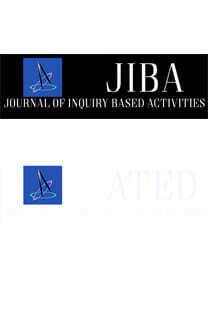ÖRÜMCEK Mİ BÖCEK Mİ? 5.SINIF ÖĞRENCİLERİ İÇİN ARGÜMANTASYON TABANLI SINIFLANDIRMA ETKİNLİĞİ
A SPIDER OR AN INSECT? ARGUMENTATION-BASED CLASSIFICATION ACTIVITY FOR FIFTH GRADERS
___
- Bell, P. & Linn, M. C. (2000). Scientific arguments as learning artifacts: Designing for learning from the web with KIE. International Journal of Science Education, 22(8), 797-817. doi:10.1080/095006900412284
- Cardak, O. (2009). Science students misconceptions about birds. Scientific Research and Essays, 4(12), 1518-1522. Retrieved from http://www.academicjournals.org/sre/PD F/pdf2009/Dec/Cardak.pdf
- Çinici, A. (1997). Lise öğrencilerinin hayvanların sınıflandırılması ile ilgili alternatif kavramları : Omurgalı hayvanlar. Türk Fen Eğitimi Dergisi, 8(4), 171-187.
- Duschl, R. A., Schweingruber, H., & Shouse, A. . (2007). Taking science to school: Learning and teaching science in grades k-8. Washington, DC: National Academies Press.
- Erduran, S., Simon, S., & Osborne, J. (2004). TAPping into argumentation: Developments in the application of Toulmin's Argument Pattern for studying science discourse. Science Education, 88(6), 915-933. doi:10.1002/sce.20012
- Evagorou, M. & Osborne, J. (2013). Exploring young students' collaborative argumentation within a socioscientific issue. Journal of Research in Science Teaching, 50(2), 209-237. doi:10.1002/tea.21076
- Gobert, J. D. & Buckley, B. C. (2000). Introduction to model-based teaching and learning in science education. International Journal of Science Education, 22(9), 891-894. doi:10.1080/095006900416839
- Günel, M., Memiş, E., & Büyükkasap, E. (2010). Yaparak yazarak bilim öğrenimiYYBÖ yaklaşımının ilköğretim öğrencilerinin fen akademik başarısına ve fen ve teknoloji dersine yönelik tutumuna etkisi. Education and Science, 35, 155.
- Kelly, G. J. (2008). Inquiry, activity, and epistemic practice. In R. A. Duschl ve R. E. Grandy (Eds.), Teaching scientific inquiry: Recommendations for research and implementation (pp. 99-117). Rotterdam, The Netharlands: Sense Publishers.
- Kubiatko, M. & Prokop, P. (2007). Pupils' misconceptions about mammals. Journal of Baltic Science Education, 6(1), 5-15.
- Lin, T.-C., Lin, T.-J., & Tsai, C.-C. (2014). Research trends in science education from 2008 to 20012: A content analysis of publications in selected journals. International Journal of Science Education, 36(8), 1346-1372. doi:10.1080/09500690802314876
- Linn, M. C., Eylon, B. S., & Davis, E. A. (2004). The knowledge integration perspective on learning. In M. C. Linn, E. A. Davis, ve P. Bell (Eds.), Internet environments for science education. Mahwah, NJ: Lawrence Erlbaum Associates.
- Linn, M. C., Songer, N. B., & Eylon, B. S. (1996). Shifts and convergences in science learning and instruction. In D. C. Berliner ve R. C. Calfee (Eds.), Handbook of educational psychology (pp. 438-490). New York: Macmillan.
- McNeill, K. L., Pimentel, D. S., & Strauss, E. G. (2013). The impact of high school science teachers' beliefs, curricular enactments, and experience on student learning during an inquiry-based urban ecology curriculum. International Journal of Science Education, 35(15), 2608-2644. doi:10.1080/09500693.2011.618193
- Milli Eğitim Bakanlığı. (2013). İlköğretim kurumları fen bilimleri dersi öğretim programı. Ankara: Talim Terbiye Kurulu Başkanlığı.
- Namdar, B. & Shen, J. (2015). Modelingoriented assessment in K-12 science education: A synthesis of research from 1980 to 2013 and new directions. International Journal of Science Education, 37(7), 993-1023. doi:10.1080/09500693.2015.1012185
- National Resarch Council. (1996). National science education standards. Washington, DC: National Academies Press.
- National Reseach Council. (2012). A framework for K-12 science education: Practices, crosscutting concepts, and core ideas. Committee on conceptual framework for the new K-12 science education standards. Washington, DC: The National Academies Press.
- NGSS Leads States. (2013). Next generation science standards: For states, by states. Washington, DC: The National Academies Press.
- Osborne, J. (2010). Arguing to learn in science: the role of collaborative, critical discourse. Science (New York, N.Y.), 328(5977), 463-6. doi:10.1126/science.1183944
- Pallant, A. & Lee, H.-S. (2014). Constructing scientific arguments using evidence from dynamic computational climate models. Journal of Science Education and Technology. doi:10.1007/s10956-014- 9499-3
- Reike, R. D. & Sillars, M. O. (1993). Argumentation and critical decision making (3rd ed.). New York, NY: Harper-Collins College Publishers.
- Saka, A., Ayas, A., & Enginar, İ. (2002). Öğrencilerin omurgalı-omurgasız canlılar ile ilgili görüşlerinin yaşlara göre değişimi. V. Ulusal Fen Bilimleri ve Matematik Eğitimi Kongresi. ODTÜ, Ankara
- Shen, J., Lei, J., Chang, H. Y., & Namdar, B. (2014). Technology-enhanced, modelingbased instruction (TMBI) in science education. In J. M. Spector, M. D. Merril, J. Elen, ve M. J. Bishop (Eds.), Handbook of Research on Educational Communications and Technology (4th ed., pp. 529-540). New York: Springer.
- Toulmin, S. (1958). The uses of argument. Cambridge, UK: Cambridge University Press.
- Ulu, C. & Bayram, H. (2015). Argümantasyon tabanlı bilim öğrenme yaklaşımına dayalı laboratuvar etkinliklerinin 7 . sınıf öğrencilerinin kavram öğrenmelerine etkisi: yaşamımızdaki elektrik ünitesi. Pamukkale Üniversitesi Eğitim Fakültesi Dergisi, 37(1), 63-77.
- Varelas, M., Pappas, C. C., Kane, J. M., & Arsenault, A. (2008). Urban primarygrade children think and talk science: Curricular and instructional practices that nurture participation and argumentation. Science Education, 92, 65-95. doi:10.1002/sce
- Yen, C., Yao, T., & Chiu, Y. (2004). Alternative conceptions in animal classification focusing on amphibians and reptiles: a cross-age study. International Journal of Science and Mathematics Education, 2, 159-174.
- Yerrick, R. K. (2000). Lower track cience students ' argumentation and open inquiry instruction. Journal of Research in Science Teaching, 37(8), 807-838. doi:10.1002/1098- 2736(200010)37:8_____807::AIDTEA4>3.0.CO;2-7
- Yeşildağ-Hasançebı , F. & Günel, M. (2013). Effects of argumentation based inquiry approach on disadvantaged students' science achivement. Elementary Education Online, 12(4), 1056-1073. Retrieved from http://ilkogretimonline.org.tr/vol12say4/v12s4m11.pdf
- Zohar, A. & Nemet, F. (2002). Fostering students' knowledge and argumentation skills through dilemmas in human genetics. Journal of Research in Science Teaching, 39(1), 35-62. doi:10.1002/tea.10008
- ISSN: 2146-5711
- Yayın Aralığı: 2
- Başlangıç: 2011
- Yayıncı: Mustafa ÇAKIR
PROTECT THE ENVIRONMENT, TAKE YOUR BREATH
SABRİYE ŞENER, Ayten ÇOKÇALIŞKAN
ÖRÜMCEK Mİ BÖCEK Mİ? 5.SINIF ÖĞRENCİLERİ İÇİN ARGÜMANTASYON TABANLI SINIFLANDIRMA ETKİNLİĞİ
Bahadır NAMDAR, AYŞEGÜL DEMİR YETİŞ
TARİHTE TÜRK KADINLARI VE İLKLER
MUHAMMET AVAROĞULLARI, Zülfü ÇAPAR
